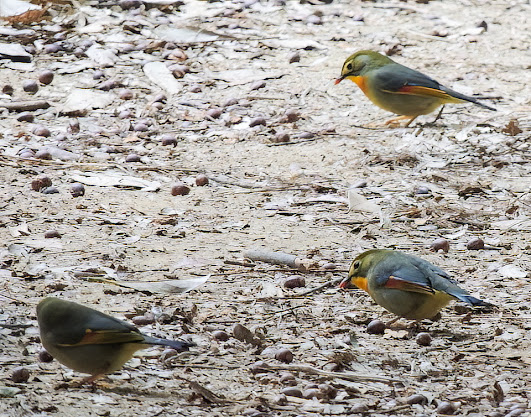AJP found this flock of five birds in the Tai Po Kau reserve in Hong Kong a couple of weeks ago. They were on a forest path in the low light of early morning. The bane of all birdwatchers—a dog walker—put them to flight.
Birdwatchers in Hong Kong can never quite decide the origins of some of the birds that can be seen there. Because the Red-billed Leiothrix (Leiothrix lutea) was and is commonly imported to the bird markets and shops, any that were seen anywhere in Hong Kong were considered to be escapees or ‘introduced’. Then, when small flocks were spotted in rural areas, the possibility that some of those seen may have been genuinely wild was admitted. I see the current edition of the Field Guide is back to a captive origin. There is no reason why they should not be present. Hong Kong does seem within the natural range but with the deforestation that occurred for firewood as the human population grew and then, devastatingly, during the Japanese Occupation, it is perhaps not surprising they could find little or no suitable habitat. Since the 1960s, cover with trees and shrubs has increased but it is perhaps not surprising that the old forest reserve (planted, sadly, in parts by foresters with non-native trees) has a healthy population. The Field Guide has it as an uncommon and local resident but if it is that uncommon then we would not have seen it every time we have been to Tai Po Kau.
In the wild, Pekin Robins, sorry Red-billed Leiothrix, occur from the Himalayas to throughout southern China. We have seen them in Bhutan, in Sichuan as well as in Hong Kong.
The name Pekin Robin for this bird was the norm for both birdwatchers throughout the world and aviculturists. OK it is not native to Pekin (Beijing in pinyin) nor is it a robin but there are so many such anomalies in common names for birds that one more would have made no difference.
Stunningly attractive, the Pekin Robin was also the cheapest ‘softbill’ available to birdkeepers in the 20th century. It is not surprising it was traded across the world in such large numbers. ‘Softbills’ do not crack seed and in captivity are fed a ‘soft’ mixture including dried fruit and insects. They can also survive outside in England in a sheltered aviary throughout the winter. Since escapees have established populations in Italy, France, Spain and Portugal as well as in Japan, Hawaii and Réunion, there have been suggestions they could become—or already have become—established in England.


No comments:
Post a Comment